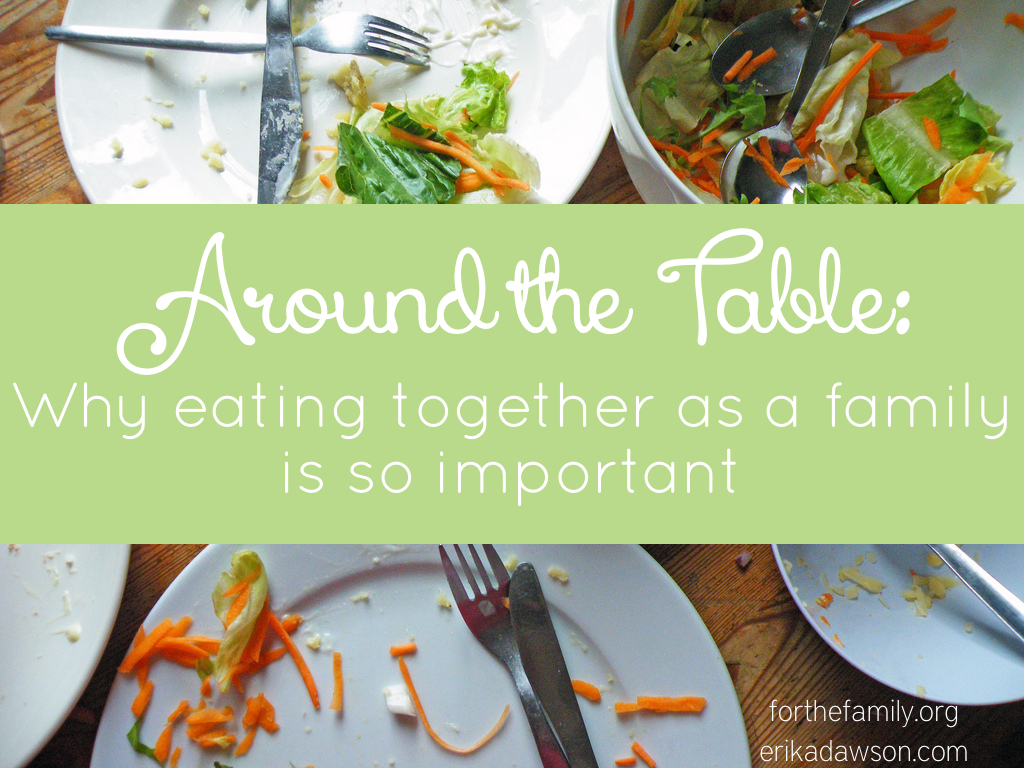Family Meals: Why Eating Together as a Family Is So Important
The research is shared often: kids who eat family meals together are more likely to do well in school, make healthier choices, feel more connected with their families, sense that their parents are proud of them, and have a more positive outlook on life.
In their book The Hour that Matters Most, Les and Leslie Parrot state:
Study after study shows that the more often families eat together, the less likely the kids are to smoke, drink, do drugs, get depressed, develop eating disorders, become overweight, and consider suicide.
Those are the studies, but here is the reality: eating together as a family is challenging!
Between busy schedules, cranky kids, and exhausted families, flipping on the TV or feeding the kids before sitting down as a couple is often easier than establishing a regular time of eating together as a family.
In our home, my husband’s work schedule changes from week to week, and we have a new baby. As a result, regular mealtimes are a challenge for us!
Even so, we are working hard to establish regular mealtimes together as a family.
There are definitely days, though, when I am overwhelmed by the work of preparing or maintaining family meals and I wonder if it’s worth the effort, so I wrote this list detailing why family meals are important, and what I hope our family gains through the effort.
Family Mealtimes Nurture Conversation and Relationship
I remember my husband sharing about a conversation he had with a co-worker whose kids are grown. She told how one of their family’s favorite things to do, even now that her kids are adults, is to sit at the dinner table and have long conversations together as a family. She went on to say that her kids weren’t naturally inclined to just sit and talk (shocker, right?!). Developing that pattern was something they worked at from the time the kids were little.
Rather than being dismissed immediately after eating, this family cultivated conversation at the table. As the kids grew, that time together as a family became a pillar of their day, helping not only to deepen relationships but also to process life!
My grandma has modeled this same principle to me. I can’t tell you how many times we would all tease Grandma about her desire to sit and sip coffee after we had all finished eating, but secretly we all loved it. And now that “after meal” time is one of my favorites. We sit long and sip and talk together in a way that our fast-paced lives normally don’t allow.
Action Point: Talk together — share highs and lows for the day, upcoming plans, ideas, etc. Share lives together. Give everyone a chance to talk, and set the expectation that each person tells something.
Family Mealtimes Nurture Prayer
How easy it is to zoom through our days without stopping to pray! We have found that at mealtimes, we can either rush through a perfunctory prayer, or we can use this time to nurture prayer.
Mealtime prayers don’t need to be long or complicated; we just want them to be sincere. We are talking with God! Stopping to pray together at meals is another opportunity to help our kids move away from rote routine to engage in relationship with the living God!
Action Point: If you need more ideas for mealtime prayers, check out my post about family prayer times.
Family Mealtimes Nurture Thankfulness
We have been working hard at thankfulness in our home! Seems that lately, especially, we have all been struggling with grumbling and complaining — it comes so easily, doesn’t it?
One time to really focus on gratitude is when we come to the table. We’ve kept it simple, but before our prayer time at family meals, we slow down and share one thing for which we are grateful. Then we make sure to thank God for it when we pray.
Action Point: Start small and model what you mean. Before you begin your meal or while you’re eating, share something for which you are thankful or tell about how you saw God at work in your day.
Family Mealtimes Nurture Honor
I have to admit that we haven’t focused on this yet, but this goal is really important to me. I want my kids to not only “honor their father and mother” but to show honor to one another.
Romans 12:10 says, “…outdo one another in showing honor” (ESV).
I realized that our family meal times are a great opportunity to practice honoring others.
Nurturing honor can be as simple as setting out a vase of flowers with a pretty tablecloth or giving up the “prized” seat at the table. It might mean letting someone else start the favorite dish first or setting out the china and lighting some candles. The emphasis is, how can you make your family members feel special? Feel honored?
I remember so many occasions where my grandma would spread the lace tablecloth, add doilies to the serving platters, and place flowers and candles as a centerpiece — just as a way to make an ordinary dinner extra special. I don’t have lace and doilies, but leftover Frozen-themed paper plates and napkins were a huge hit with my kids one evening!
Action Point: Brainstorm a list of how to demonstrate honor. Include easy options as well as ideas that will take a little more effort, and then mark your calendar to model this idea at least once a month. As the kids begin to notice, start brainstorming together ways they can show honor to one another at mealtimes.
Family Mealtimes Nurture Practical Skills
I’m working on this piece, too, because let’s be honest, so many times preparing a meal is much easier done alone. But including my kids in the process is a great opportunity for them to develop and practice practical life skills. By involving the children in meal preparation and service, they can learn how to work together in the kitchen, to set and clear the table, to do basic cooking and food preparation tasks, to practice table manners.
Action Point: Get in a habit of having the kids help in the kitchen. Start small — one helper, one time a week — and focus on one skill like setting the table, how to wash or slice the vegetables, or filling the water glasses.
Here’s to nurturing — and enjoying — family mealtimes together!
Blessings,
Erika
Resources for You:
How to establish Family Meal Times — Practical ideas for establishing family meal times in your home {includes a FREE PDF of discussion starters for you to use around the family table during the month of July!}
Q & A a Day for Kids: A Three Year Journal {3 Years, 365 Questions: 1,095 conversations with your Kid} — We recently started using this journal each day at our family meal times, and we’ve so enjoyed it! Not only do we have a question a day to get us started, but there is a place to record each of our answers both today and for the next two years. I’m excited to read back through our answers each year and see how we’ve changed!
The Hour that Matters Most by Les and Leslie Parrott
Question for You:
Do you maintain a regular family meal time? Why or why not? What other reasons would you add to this list?
Original Flickr Photo Credit: Kate Hiscock








We have started making this a priority in the past three years, mostly because I felt convicted by all the studies saying how big big of a difference it makes. I can honestly say what started out feeling like another thing on the “to-do” list has become a huge blessing for all of us. I love the intentionality it creates…no screens, no books, no toys. Just the four of us, enjoying each others company and conversation. Thank you for sharing your ideas and conviction.
My husband, two daughters (ages 9 and 11) and I have dinner together almost every night. We sit at the table, start with grace, have music playing, talk about our days or whatever is on our minds – sometimes serious, sometimes nonsensical – and finish up with a reading and discussion from a devotional book. Devotional time is not just my husband or me speaking and the girls just listening: often the girls have more to add than WE do! Also, no phones, books, games, etc., at the table: only an MP3 player (it has a built-in speaker) and the devotional book. Sure, sometimes we’ll have “casual” dinner in front of the TV, but that’s rare. We’ve done this ever since the girls ate solid foods.
What type of questions are in your journal, if you don’t mind me asking. Thanks & God Bless.
I love this idea. As a homeschool mom of four, we don’t do it much at breakfast or lunch but it’s a MUST at dinner time that we all are sitting at the table for dinner. Most of the time the table is already set. My mother in law, myself(depending on whose cooking) or the girls (we have three, 9 and a half, 8, and 5) will set the table. My husband comes home from work, showers while I or my mother in law (mom) prepares the rest of the dinner, if the kids are outside, they come in from outside to wash up and we all sit down at the table. My son who’s almost 13 will get cups or glasses of ice to set. We pray to thank God for his provisions, His grace and Mercy and for the food to become nourishment to our bodies in Jesus name, Amen. Then we eat. It is so good when everyone is at the table to eat. Conversations, laughter, thoughts and sometimes tattles are all heard, but it’s a good time shared by all. Then, when we are done, the kids have the kitchen. From clearing the table to loading the dishwasher to sweeping the floor and washing down the stove and counter tops. My son usually washes the big pots, if there are any, but we all do our part. I love this article. It teaches teamwork, responsibility and thankfulness.
When my girls were little I started passing three things around the dinner table to promote conversation. A gross bug-filled ball that we found at the dollar store. (What was the bad part of your day?) A large glass “diamond.” (What was the best part of your day?) And a plastic glittery cross. (What was the “Jesus” part of your day — something He told you, helped you with, or something you are thankful for?) The insights I got from having each member of our family share these three things around the dinner table were amazing. They opened up conversations that I’m sure we would never have had otherwise, they give us things to pray for and increase our empathy for each other. Even though we no longer pass around the objects, we still share those 3 — and so do guests who come to our table! I’m so thankful that God placed this idea in my mind all those years ago and hope my girls continue the tradition with their own families. 🙂